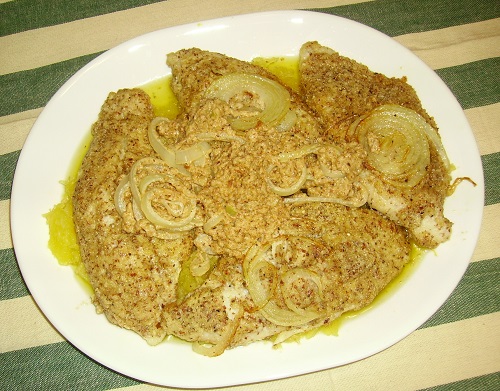What causes that beckoning aroma after a rain? What causes the alluring fragrance of fresh-plowed soil? What causes the enticing earthy spice in beets?
Geosmin! (Say: GEE oze min.)
Geosmin is a bicyclic alcohol, responsible for transforming common things such as rain, into perfume.
You wouldn’t think it would also create the muddy taste that sometimes occurs in catfish, but it does.
Don’t worry! It won’t harm you any more than tipping up your face and catching Spring raindrops on your tongue.
But mostly, we don’t exactly prefer it in our catfish, do we?
They say to avoid it in fish we should hook them during cool weather, remove any dark-colored flesh, soak the rest in milk or vinegar, and several other tactics.
Scientists predict the vinegar actually could work, because geosmin breaks down when exposed to acid. But wouldn’t the fish taste pickled? And doesn’t milk include acid? I vote for milk!
However, once that part is over you know you must dredge catfish in cornmeal or coat it in a heavy batter; deep fry it in peanut oil; also fry breaded onion rings, French fries, and hush puppies (which are blobs of cornmeal mush stuff left over from breading or battering things). Then you can sit down and eat all that greasy food, most of which is heavily loaded with carbohydrates, a bad mix for many diets, these days.
I wanted something different. (I’m from the north, y’all!)
Since in our family, we all like to eat fish and don’t even mind enjoying a bit of catfish on occasion, I decided to invent a recipe for frying catfish that would be more health-giving for us. I love inventing recipes! I decided to pan fry on a lower heat and to use a health-friendlier oil, plus a breading that is low in carbohydrates.
The first task was to pick the breading ingredients. After considering coconut flour, almond flour, soy flour, flax meal, and whole wheat, I decided to go with whole almond flour. I reasoned that if we did not like something that mild, we certainly would not appreciate all the rest, and definitely not a mixture.
After that, I had to decide upon an oil. The first time I made this dish, I used olive; the second time I tried coconut oil. I suppose I’ll make this many times, to decide finally, but right now I’m leaning toward olive oil.
Then, to replace the carb-high potatoes and corn, I wanted to try marrow squash, also known as “spaghetti squash”. We’d enjoyed it merely buttered, and a few times supporting various Italian sauces. This would be an enormous departure from the traditional Southern experience, but a food adventure I was ready to try.
Finally, to round it off, I chose good ol’ low-glycemic, vitamin-loaded sweet potatoes. Boiled and buttered, they are one of our favorite go-to sides.

I had to buy the squash. Although it is easy enough to grow in Arkansas, and keeps quite well in a cool dark place, the deer have attacked our gardens with great gusto the last couple of years. I’m happy for their dietary enrichment, but I’m about to join our neighbor down the highway, who has fenced his garden with ten-foot chain link topped with razor wire.
I kid you not. The critters are thick around here.
But back to the kitchen!
Steaming a marrow squash is easy enough to do if you own a steamer. Just quarter, remove the seeds and excess membrane, and place it in the steamer over boiling water to simmer for about 20 minutes, or until fork-tender.
The difficult part is opening it before cooking, and that can be a mildly dangerous task if you don’t know how. I use a large knife that is recently sharpened, and watching out for my fingers, I aim for the center, chopping the squash once with the sharp edge of the knife. It usually cuts about ½” deep into the fruit. At that point, I can lift the knife, which is jammed hard into the squash, and the squash lifts with it. Taking care to keep fingers in safe places, I raise the knife, heavy with the squash, about four inches and then bang the squash, with the knife in it, down hard on the cutting board. I may have to repeat, but this works well. Once you have it in halves, clean out the seeds and loose fibers. Then quartering it is surprisingly easy.
I like to multi-task when I’m cooking, so I usually start the squash steaming before I work on the other parts of the recipe. That way the squash can have time to cool for handling, and then be warmed again before serving.
Another word of caution, this time about releasing the “spaghetti” from the cooked squash shell: It must be cooled, first. There are very few ways to handle a piece of food that is boiling hot. Potholders, I found, will soak through and can scald you. I’ve used tongs before, but that’s awkward. It really is best to let the squash cool on a plate, flesh-side up, about ten minutes, shred it out of the shell, and then reheat the “spaghetti”.
If you have more of the squash than you need, for this meal, it is delicious when reheated, with or without a chopped green onion and some pepper, in a buttered pan with a lid. Add a bit of cream and shredded cheddar cheese at the last minute, and it makes another lovely, and very quick, side for low-carb enjoyment.
The recipe shown here includes four catfish filets. It was a lot for two people to eat, really, but I was hoping for left-overs.
And I think you will, too.
Ingredients
- "4 large (aproximately 4 ounce) catfish filets
- 2 cups milk
- 1 marrow squash (spaghetti squash)
- ½ teaspoon black pepper
- 1 cup olive oil or cooking oil of choice
- 1 egg, beaten
- 4, ¼” slices of onion
- Salt to taste
- 1/2 cup additional almond flour, if needed
- ½ cup Chardonnay, Chablis, or white Zinfandel "
Instructions
- Thaw (or soak) filets in milk for 4 hours in refrigerator.
- Wash squash. Cut in half. Scoop out seeds and loose membrane. Cut into quarters or eighths. Steam 20 minutes or until flesh separates easily. Allow to cool ten minutes or to handling temperature. Remove flesh and arrange on ovenproof platter and keep in 150 degree oven.
- Remove fish from milk. Rinse and drain.
- Mix almond flour and pepper in shallow dish such as a pie plate.
- Heat oil in non-stick skillet to “splatter” temperature.
- Coat one filet in egg, then in almond flour/pepper mix.
- Place one onion slice in oil in pan and top with one coated filet.
- Repeat for each filet/onion slice.
- Fry filets on onion slices, uncovered, for about 7 minutes. Turn filets with onion slices, allowing onion to rest on filet. Salt lightly
- Fry until filet separates easily.
- Remove filets to top the squash on platter. Return platter to warm oven.
- Pour most of hot oil into heat-proof container to cool, being careful to keep as much pan residue in pan as possible. Try to retain only about two tablespoons of oil in pan.
- Return pan to heat, bringing to medium-high temperature. Stir in remaining almond flour left from breading filets, and stir constantly to brown slightly. If no flour is remaining, stir in 1/2 cup additional almond flour and brown. Immediately de-glaze pan with wine, continuing stirring until slightly thickened.
- Pour sauce over filets and squash. Serve immediately.
Notes
Multitasking Note: If you desire to serve the sweet potato as a side with this dish, peel, slice, and boil 1/2 potato for each serving, while steaming squash, then keep warm in ovenproof dish with lid, in warm oven with squash.



We eat fried cat fish occasionally–always out. I can’t abide that muddy taste you mentioned. It’s not hard for me to forego french fries, and I can eat only one onion ring, but if the hushpuppies are good, I have to reign myself in. We can get a baked potato and salad at our usual place, and they don’t serve hushpuppies, so it feels a bit healthier. Thanks for giving us a healthy alternative.
Ahh…You are welcome, Dorothy! However–sometimes the fish are good. It’s all about the “sometimes” I think! 😀
Sounds wonderful Katharine, great job. We are a low carb southern family so we always have spaghetti squash in the house so I am looking forward to trying your recipe. I have found that if you trim off the end of the squash where the stem is then standing it upright on that cut end you can use your big knife to cut straight down the middle with carefully pressing down on the knife. They are tricky things to cut for sure but so worth the effort, right? Yum.
Southern! I guess I should be, too, having lived here about 40 years! Ha!
Yes, yum and worth the effort.Thanks so much for the tip about cutting that rolly rascal! Safety first is a big deal for me, and I think your way will add a lot to my future attempts.
What a lovely recipe. Lightening up traditional catfish would mean that I could enjoy more hush puppies!
Haha! Colleen! What a laugh! Yes, I suppose it does!
And thanks for your kind words! Hope you enjoy preparing .dish as much as I do